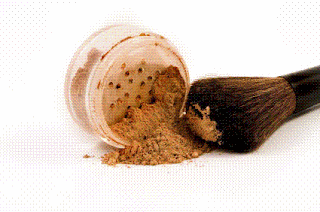Wednesday, 3 March 2010
Foundation Week - Powder
Foundations come in all shapes, sizes and formats, I'm spending a day on each of the main types of foundation (powder, cream, and I'm splitting liquids into matte, and dewy, but I think a mousse might slip into at least one of those, so be warned!) and I'm starting with powder, as they can be a bit less scary than full on foundation ...
Loose/Minerals
Trendy among powder formulations at the moment are mineral foundations, I know a lot of people find them difficult to work with - they're generally loose powders that you "buff" over the skin with a large brush to give you an airbrushed look. The trick with these is to use a very, very light hand at first, and build up the coverage until you have a look you're happy with. Use a very small amount on your brush, then knock the excess off before applying to your face.
Pros: It's very easy to get a nice, even, buildable coverage. Many of them are made of natural ingredients, and contain nothing in the way of synthetic dyes. They're supposed to be less irritating than traditional-style liquid foundations. They multi-task, as you can use the same product as concealer, if you use a smaller synthetic brush.
Cons: many of them contain bismuth, meaning they can leave you looking rather "plastic" or "artificial" (aka "fembot"). Bismuth can also make the product feel a bit like you're wearing a mask. Also, the buffing motion itself can lead to aggravated and irritated skin.
I like Bare Escentuals - even though it's trendy not to, but I'll be talking more about Bare Escentuals later on in the week - and Christopher Drummond is an excellent - albeit expensive - alternative.
Recently, I've been using a Cosmetics a la Carte powder foundation, Cover Tint in Sand. I like the packaging, as it doesn't require an additional brush, and comes complete with a mirror (a proper mirror, not just a silver painted top, which you have to squint into) in the lid. CalC foundations don't contain bismuth, and I've found the coverage to be extremely buildable, meaning that I've been able to use this both on it's own as a full foundation, and as a finishing powder over liquid formulations. Basically you just dot this on your face, and then "smoosh" the puff around a little to distribute it, if you want a lighter look, or dot repeatedly, if you want to build up to full-face coverage. Priced at £30 for an off-the-shelf shade, or £45 if you want a custom blend shade made to your own requirements, it's very quickly become a makeup bag staple for me.
Pressed
Pressed powder formulations have been around forever, and I recommend MAC studio fix to any of my personal shopping clients who are too scared to think about a "traditional" liquid foundation. Benefit's Hello Flawless is also a good one, but it has a very small colour range, whereas MAC is outstanding in that area in comparison.
Powder foundations are simple and easy to use, but they don't always work for dryer skins, and you do need to make sure that you're well moisturised if you are at all prone to dryness before using them. But they're a godsend to our greasier-skinned sisters!
Do you use powder foundations? What do you recommend I should have a look out for?
The small print: I was sent the Cosmetics a la Carte foundation for consideration to review, all other opinions on foundations in this roundup are based on items I already own. Opinions are impartial and honest regardless of the source of the product.
Subscribe to:
Post Comments (Atom)
©
Get Lippie | All rights reserved.


i adore Lily Lolo foundation. It's possibly the only foundation I've ever repurchased and I must be on my 6th pot or so. Although it lasts a long long time. The coverage is good but it looks so natural but lately I've been craving having the option of a liquid so I'm on the quest, as you know, for my HG cream/liquid foundation!
ReplyDeleteOk, what is the difference between MAC Studio Fix and Blot? I've realised I don't really understand when a powder is foundation and when it's, umm, powder.
ReplyDeleteI usually find mineral foundations make my face itch, and I think it's the bismuth that causes that. i'm not 100% on that though.
ReplyDeleteI really like the Body Shop's all in one face base. I tend to use it dry with a brush for a quick, light coverage on quick make-up days. I've found it works well with fix+ for more coverage too.
ive just bought studio fix powder, cant wait to try it! another goody is max factors facefinity compact, only problem is the colours run quite dark so not good for pale skin xxx
ReplyDeleteAt the moment I'm using Everyday Minerals foundation. I ordered it back when you could choose 5 or 6 (can't remember!) full size items for a reasonable price. When it runs out I'm planning to order from Lily Lolo as it seems like a good UK alternative.
ReplyDeleteTo stop my face from looking like a grease ball I use MAC Blot Powder over the top as it adds no extra colour.
I love my powder foundations and much prefer them to a liquid. I keep trying liquid foundations but they always disappoint!
Ceona, the basic difference between MAC Studio Fix and Blot is pigment. The studio fix contains a fair amount of it, but blot is mainly silica, which absorbs oil, but doesn't add a lot of colour.
ReplyDelete